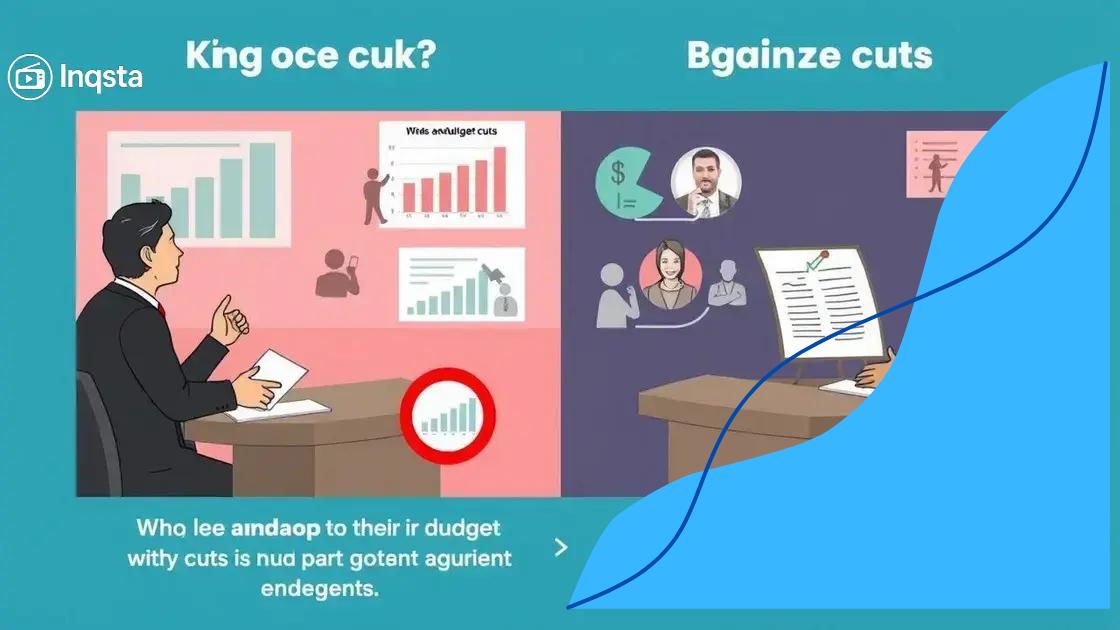Budget committee targets social program reductions

Anúncios
Budget committee targets social program reductions can significantly impact vital community services, leading to increased hardship for vulnerable populations; exploring alternatives like efficiency improvements and diverse funding sources is crucial for maintaining essential support.
Budget committee targets social program reductions, and this shift raises crucial questions about community support. What does this mean for essential services and those who rely on them? Let’s dive into the details.
Anúncios
Understanding the budget committee’s goals
The budget committee’s goals are crucial for shaping our fiscal landscape. By understanding their objectives, we can see how funding decisions affect social programs and public services.
Priorities of the Budget Committee
The committee typically focuses on several key areas when setting budgets. These priorities help direct funding towards necessary services and infrastructure.
- Identifying essential services
- Balancing fiscal responsibility with community needs
- Assessing the long-term impact of funding decisions
- Involving community feedback in budget discussions
Each goal reflects the committee’s responsibility to ensure that every dollar spent meets the needs of the community while maintaining fiscal health. A well-structured budget can create a stable environment where services can thrive.
Anúncios
Understanding the Impacts
When the committee sets its goals, it determines how funds are allocated. This can lead to changes in how communities receive services. For instance, funding cuts may impact social programs that provide assistance to the most vulnerable.
Moreover, understanding these goals helps citizens engage in budgetary discussions. Being informed allows for active participation in local governance.
As the committee establishes its priorities, consulting the community is vital. Public input helps ensure that services are aligned with the needs of the people they serve.
Communicating Goals Effectively
Effective communication of budget committee goals fosters transparency and builds trust within the community. Meetings and open forums invite discussion, revealing the committee’s rationale behind funding decisions.
- Utilizing community feedback
- Conducting public forums
- Providing clear documentation of budget proposals
- Engaging with local media for outreach
Ultimately, understanding these dynamics helps everyone in the community contribute to discussions and advocate for priorities that matter to them. Being proactive and informed can lead to better outcomes for all.
The impact of social program reductions on communities
The impact of social program reductions on communities is significant and multifaceted. When funding cuts occur, the ripple effects can disrupt essential services that many individuals rely on.
Effects on Vulnerable Populations
Social programs often target vulnerable populations, such as the elderly, low-income families, and individuals with disabilities. Reductions in these programs can lead to increased hardships for those in need.
- Loss of access to critical services
- Increased poverty rates among affected groups
- Higher levels of stress and mental health issues
- Greater demand for emergency services
As social safety nets weaken, families may struggle to meet basic needs like food and housing. This can lead to more people relying on charities and local food banks, which may be overwhelmed by the demand.
Community Resources at Risk
Funding cuts can also affect community resources, such as public health programs and educational services. These reductions may negatively impact community cohesion and overall well-being.
Communities might see fewer after-school programs, leading to a rise in juvenile delinquency. When children miss out on enrichment opportunities, their development and academic success can suffer.
- Decreased availability of after-school activities
- Less support for mental health services
- Reduced community engagement and volunteerism
- Strain on local nonprofits and services
Moreover, reduced funding can lead to staff layoffs or service closures, leaving a void that is difficult to fill. This affects the local economy as well, with many workers losing jobs tied to these programs.
Long-Term Consequences
The long-term consequences of cutting social programs often extend beyond immediate impacts. Communities may face increased healthcare costs as untreated mental health and physical health issues escalate.
Additionally, the loss of social structures can lead to greater disconnection within neighborhoods. When people feel isolated, community trust erodes, making it harder to collaborate on solutions and improvements.
Addressing these reductions requires advocacy and community engagement. Residents must come together to voice their needs and demand adequate funding for crucial services. The community’s strength lies in its collective effort to address these challenges and support one another.
Key arguments for and against budget cuts

Understanding the key arguments for and against budget cuts is essential for informed discussions about fiscal policies. Both sides present compelling cases that reflect differing priorities.
Arguments in Favor of Budget Cuts
Supporters of budget cuts argue that reducing spending is necessary for several reasons. They believe that cutting costs can lead to a more efficient government.
- Improved fiscal responsibility
- Allocation of funds to high-priority areas
- Incentivizing efficiency in public programs
- Reducing national debt and deficits
These advocates assert that when the government trims unnecessary spending, it can redirect resources to essential services. They also argue that budget cuts can force agencies to operate more efficiently and innovate in their service delivery.
Counterarguments Against Budget Cuts
On the other hand, opponents of budget cuts raise significant concerns about the negative impacts of these decisions. They argue that cutting funding can harm vulnerable populations and essential services.
- Increased poverty and inequality
- Higher demand for emergency services
- Negative effects on public health and education
- Long-term economic consequences
Critics emphasize that budget cuts often disproportionately affect those who rely most on social programs. Decreased funding can lead to dire outcomes for families, seniors, and individuals with disabilities.
Moreover, there are fears that scaling back investments in education and healthcare may stymie economic growth in the long run. A well-funded education system can be a foundation for a skilled workforce, which benefits the economy overall.
The conflict between these perspectives highlights the complex nature of budgeting. It’s not just about numbers; it’s about real lives and communities impacted by these financial decisions.
Possible alternatives to social program reductions
Exploring possible alternatives to social program reductions opens the door to creative solutions that can safeguard essential services while addressing budgetary constraints. Rather than cutting programs, there are several approaches that can stabilize funding and maintain support for vulnerable populations.
Enhancing Efficiency in Existing Programs
One approach is to improve the efficiency of current programs. By auditing existing services, organizations can identify wasteful practices and reallocate resources effectively.
- Streamlining application processes
- Improving service delivery through technology
- Training staff for better resource management
- Collaborating with local nonprofits to share resources
These steps can help programs achieve more with the same or less funding, ensuring that the needs of the community are still met while minimizing costs.
Exploring New Funding Sources
Another option is to seek alternative funding sources. Governments can look into public-private partnerships and grants to sustain social programs without over-relying on taxpayer dollars.
- Forming partnerships with businesses for funding
- Applying for federal and state grants
- Launching community fundraising initiatives
- Utilizing crowdfunding platforms for specific projects
These methods can provide financial support and foster innovative collaborations that enhance community services without necessitating cuts.
Additionally, advocacy for increased public funding is also critical. Mobilizing citizens to support social programs can raise public awareness about their importance and influence policymakers. When communities unite and voice their needs, they can effectively impact budgetary decisions.
Strengthening Community Engagement
Involving community members in decision-making processes can lead to more effective allocation of resources. By engaging citizens, governments can align budgets with the specific needs of the community.
Regular town hall meetings and surveys can provide valuable insights into what programs need more support and which ones can be adjusted without harming community welfare. This approach encourages transparency and accountability, fostering trust between citizens and their leaders.
What this means for future funding strategies
Understanding what this means for future funding strategies is crucial in the context of budget decisions. As social programs face reductions, it becomes important to rethink how funding is managed and prioritized.
Reevaluating Funding Priorities
Future funding strategies must focus on reevaluating priority areas. This involves determining which programs provide the most value to the community and ensuring they receive adequate support.
- Identifying high-impact services
- Focusing on preventive measures to reduce costs
- Assessing community needs regularly
- Engaging stakeholders in priority-setting
This process helps create a more effective allocation of resources and ensures that essential services remain functional even in tough financial times.
Diversifying Funding Sources
Another key aspect is diversifying funding sources. Relying solely on government funding can be risky, particularly when budget cuts are on the table. Future strategies should include seeking contributions from:
- Private sectors and businesses
- Grants from foundations or organizations
- Community fundraising efforts
- Public-private partnerships
Diversifying funding can provide more stability and opportunities for social programs to thrive, even when public budgets are tight.
Additionally, it is essential to develop flexible funding models that adapt to changing circumstances. By having a range of funding options, communities can respond better to immediate needs while planning for long-term goals.
Adopting Innovative Approaches
Looking forward, adopting innovative approaches can also shape future funding strategies. This can include using technology for better resource management or exploring new service delivery methods that reduce costs.
Investments in technology can enhance efficiency and cut operational costs, allowing more funds to flow into direct service delivery. Innovations such as telehealth and online support systems can connect more individuals to needed resources without the associated overhead costs.
Ultimately, reevaluating funding priorities, diversifying funding sources, and embracing innovation will lead to stronger, more resilient funding strategies that meet community needs.
FAQ – Frequently Asked Questions about Budget Cuts and Social Programs
What are the main arguments for budget cuts?
Supporters argue that budget cuts can lead to improved efficiency and better allocation of funds to essential services.
How do budget cuts impact social programs?
Budget cuts can result in reduced access to crucial services for vulnerable populations, leading to increased hardship.
What are some alternatives to cutting social programs?
Alternatives include improving efficiency in existing programs, diversifying funding sources, and engaging the community in decision-making.
How can communities prepare for future funding challenges?
Communities can focus on innovative approaches, reassess funding priorities, and mobilize citizen advocacy to protect essential services.